Main Menu
Welcome
I ended up with a total of 13 preparations in three main groups: one experimental and two control groups. The two control groups consisted of one control group that did not receive any anterior stimulation at all, but was only observed for the 30 trials of posterior stimulation. The other control group was 'yoked' to preparations from the experimental group, i.e., they received anterior stimulations whenever the preparation in the experimental group received it, but irrpective of the motor pattern the animal actually was performing.
Each preparation then received ten posterior stimulations in a pre-test phase with no anterior stimulations. In the next phase, the training phase, all three groups received another ten posterior stimulations, but their anterior stimulations differed. In the experimental group, each preparation received contingent anterior stimulation on whatever was the most frequent motor pattern (swimming or crawling). The two control groups received either no anterior stimulation od yoked stimulations (see above). In the final test phase, all groups received the same ten posterior stimulations, without any anterior stimulation. This practice of making the anterior stimulation contingent on one of the two patterns during training means that each of the three groups can be further subdivided into two sub-groups: those who initially generated more swims and those who did the opposite.In theory, this means I have thus six groups. However, I didn't get any no-stimulatio controls whic responded with more crawls than swims in the pre-test, so I have a total of 5 groups.
You can follow my evaluations of the data below the fold:
Let's start by loking at all the raw data lumped together. Of all the 13 preps in the entire observation period of 30 trials (i.e, 1.5h), how many motor patterns were produced and in what ratio? The graph below shows the mean number of patterns in each category (swim, crawl, intermediate and no patterned response) with the standard error, for 30 trials.
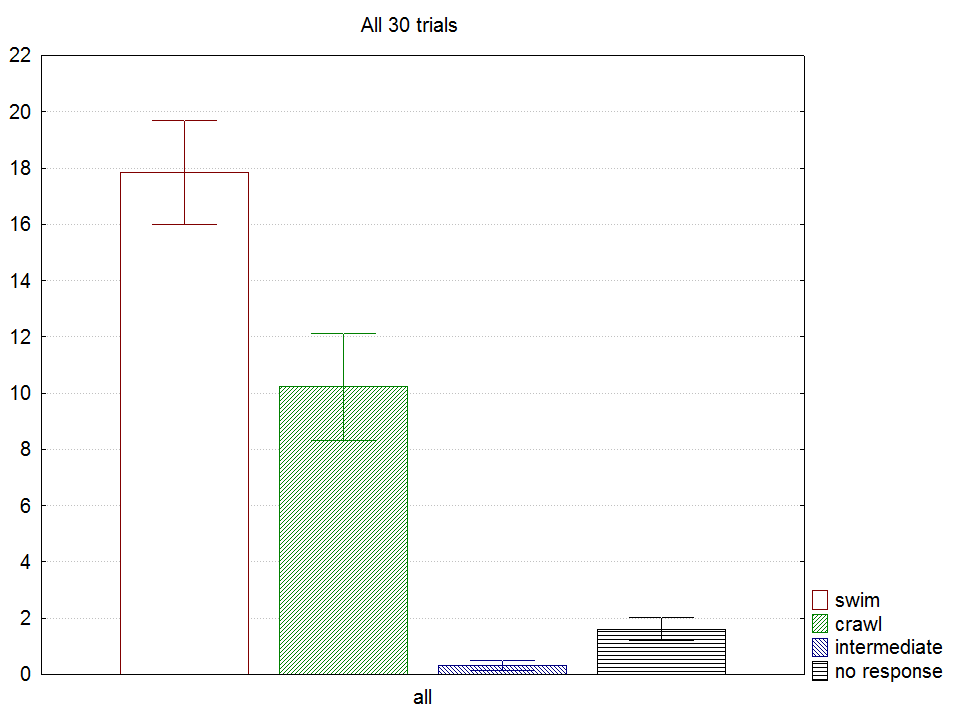
Clearly, the preparations, overall produced almost twice as many swimming patterns than crawling patterns, which is something that was immediately noticeable. Now let's have a look at how the number of patterns developed over the three experimental phases, i.e., from pre-test, to training to test:
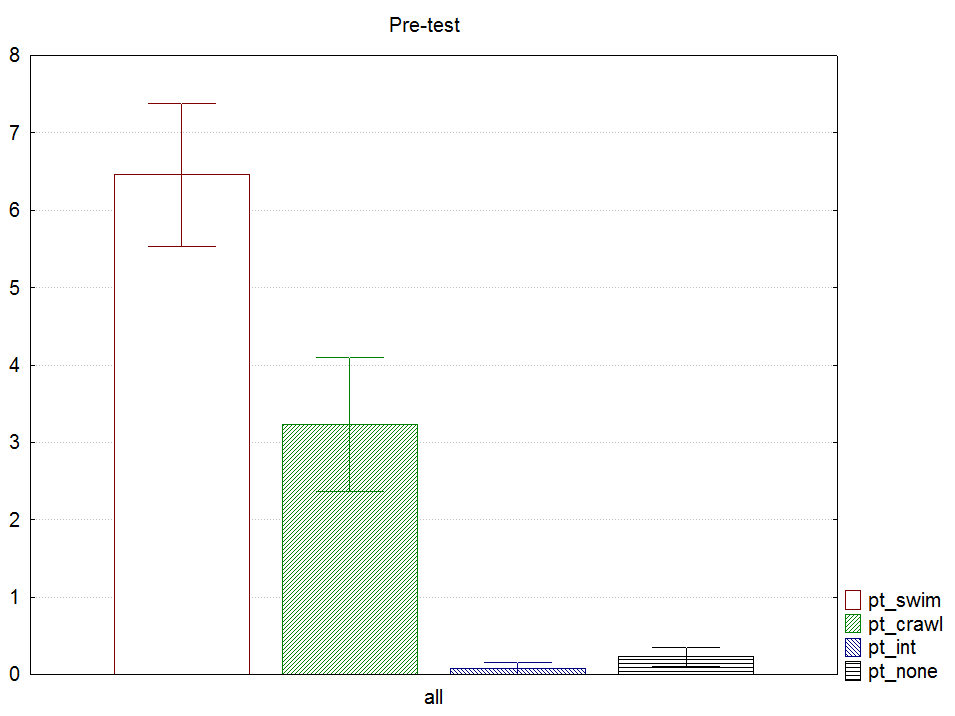
The distribution of patterns during pre-test seems to be reflecting the overall distribution very well. How about training?
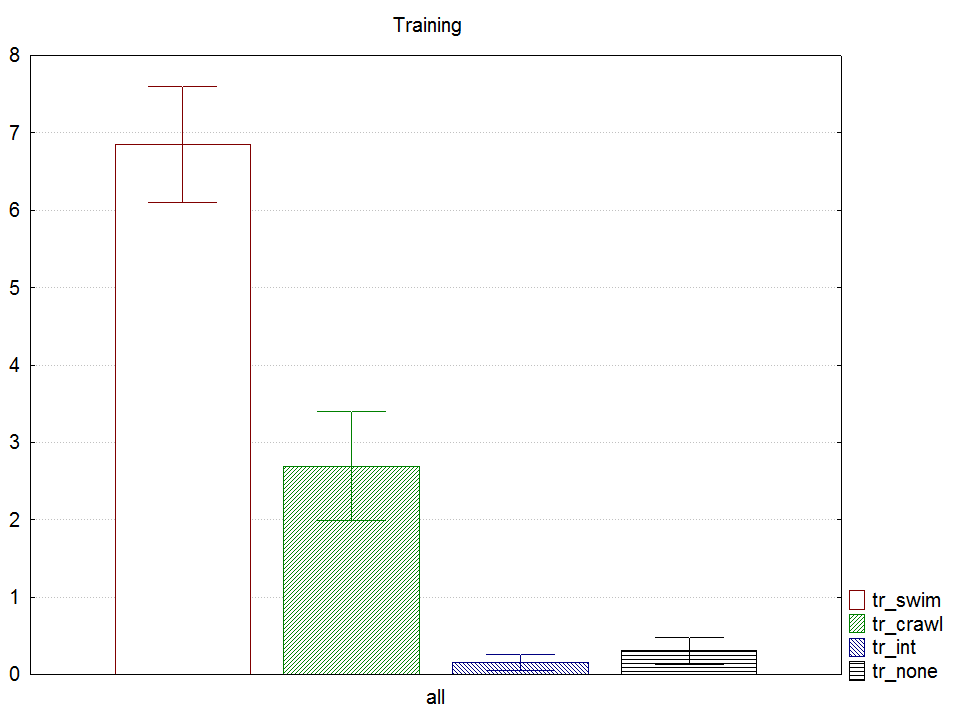
Not much sems to be going on during training, the numbers look almost identical to those during the pre-test phase. How about the test phase?
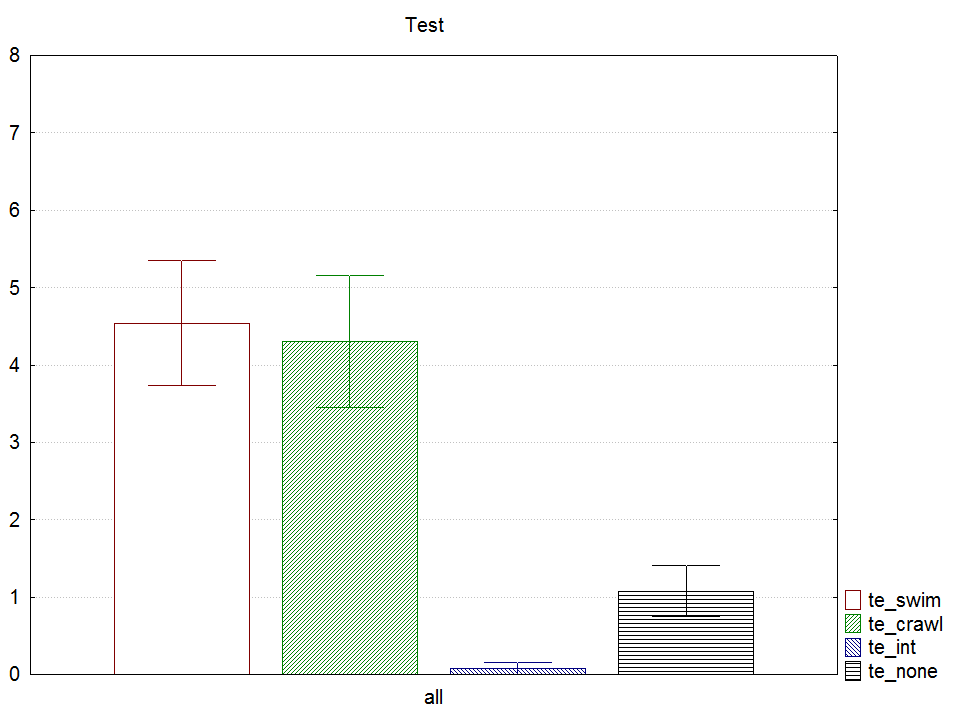
Alright! There has been some change! Let's have a look at the individual five groups, maybe these data will tell us where this sudden difference comes from. Again, we'll go thrpough the data from pre-test through training:

Because the intermediate and unrecognizable patterns didn't really constitute a large portionof the data, I'll omit them in the next plots. So we'll only look and swoms and crawls in the five groups: contingent anterior stimulation on swimming ('swim', N=3) or crawling ('crawl', N=3), no stimulation (no_s: more swimming, N=3), and yoked to an animal wich swam more (yoke_s, N=3) or to an animal which crawled more (yoke_c, N=1). So far, the data only reflect the sub-grouping into swim or crawl, respectively. Does this pattern change much during training?

The differences between the pattern numbers seem to decrease slightly in all the groups, but not really to a degree that one would be convinced that there is actually something major going on. How about the test phase, where the big difference had been seen in the overall distribution of patterns:
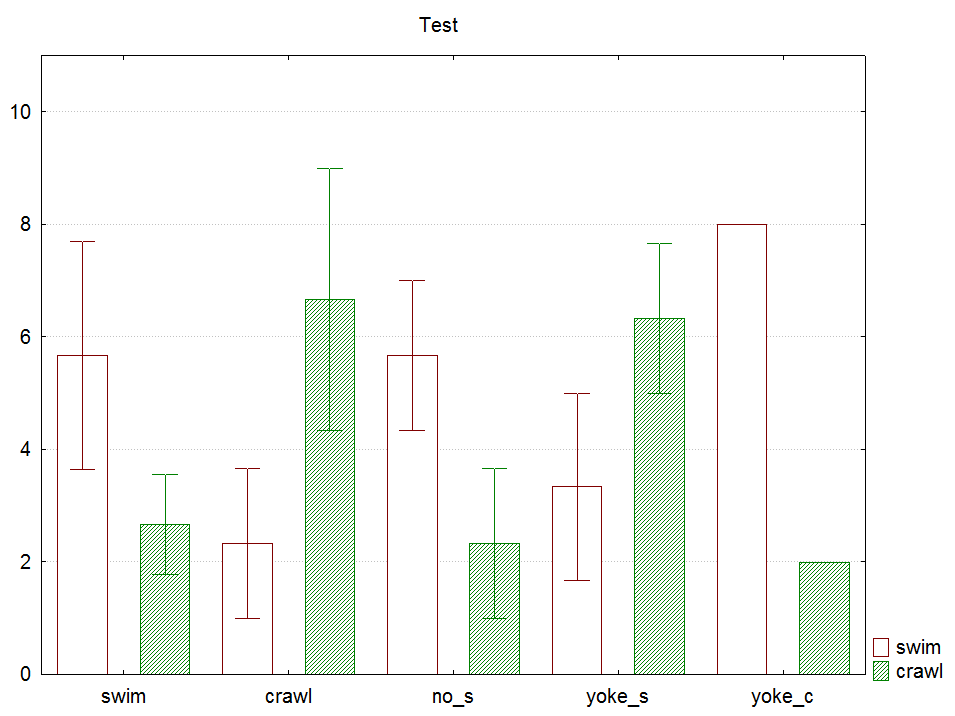
Here, the surprising results becomes clear: while the experimental preparations (i.e., swim and crawl) do bias their decisions slightly away from the patterns which were coupled with anterior stimulation, the yoked control completely switch their decisions away from the patterns which were preferentially generated during the pre-test phase!
Let's try and do some calculations to make this effect clearer. First, let's look at the difference between the number of swimming and the number of crawling patterns in each group during pre-test:
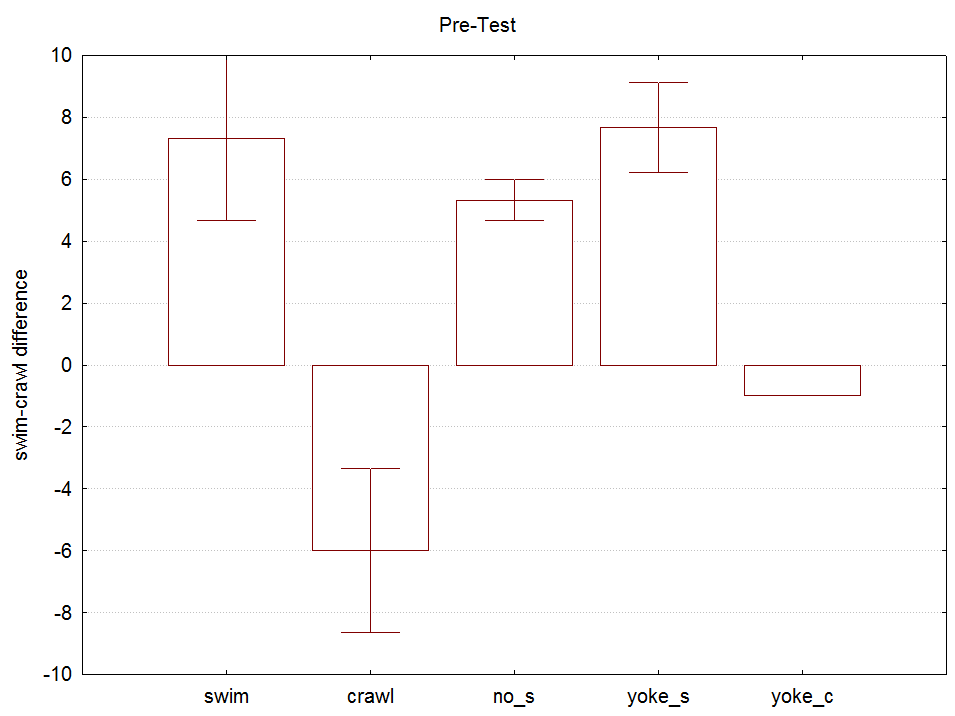
Of course, this just shows the differences we already know. The same goes for the final test phase:
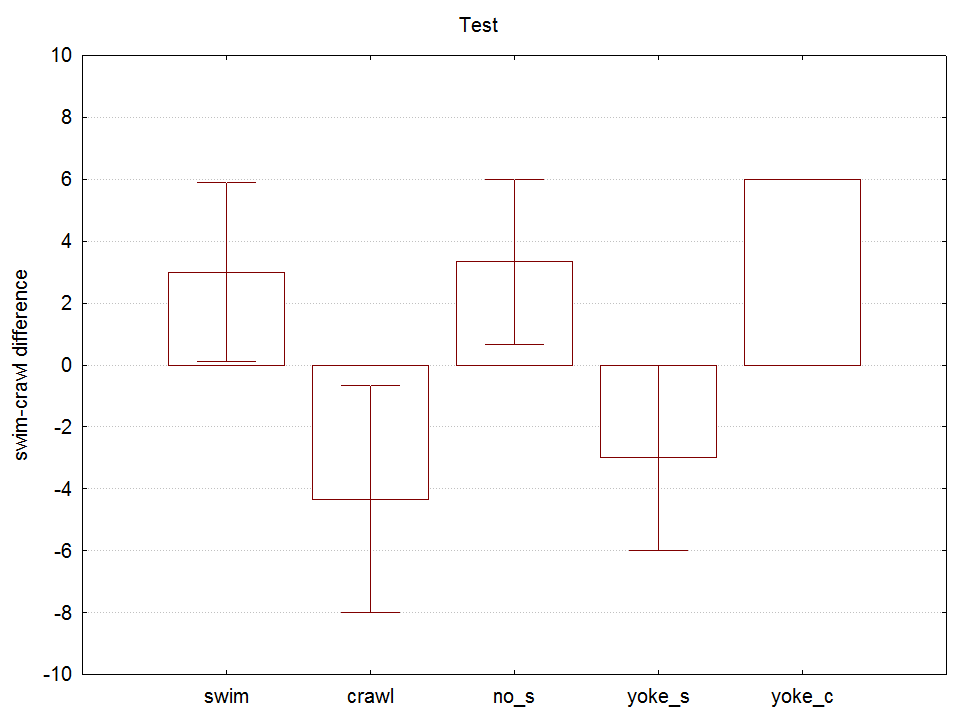
We can see that the differences have shrunk somewhat for the experimental and no-shock groups, but they have actually reversed for the yoked control groups. Now let's merge the sub-groups together to get the three experimental groups: experimental, no-shock and yoked. To do this, I invert the negative differnces and look at the change from pre-test to final test:
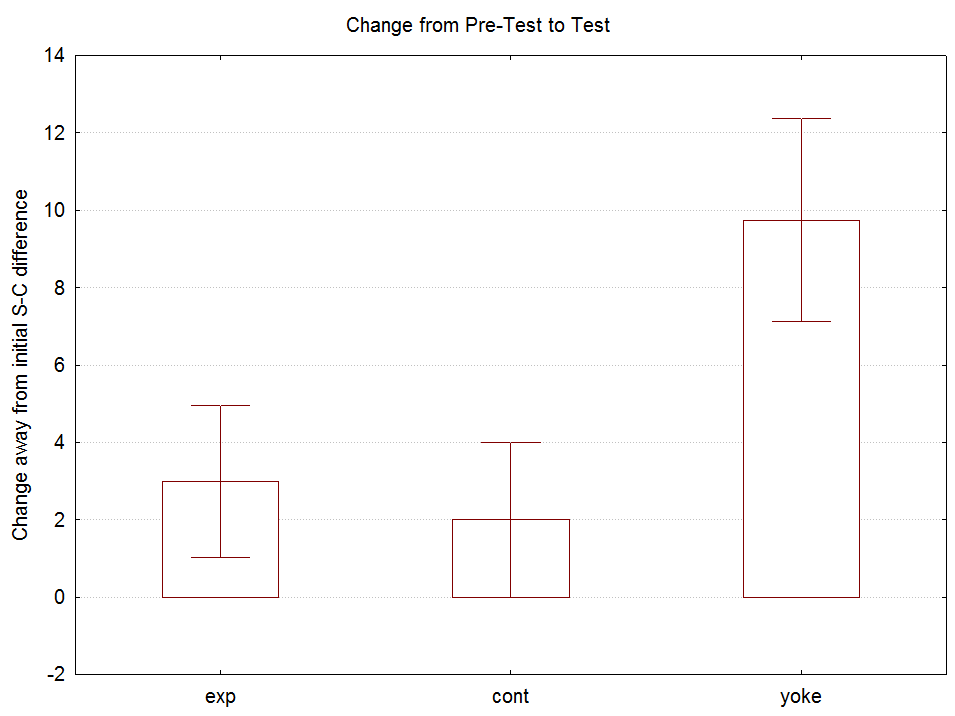
In this graph, the difference between the three groups comes out most strikingly. Now, obviously, there could be many reasons how this result could be explained. Ultimately, the most promising or exciting of these possibilties will have to be tested experimentally. If you want to play around with the raw data yourself, have a go. I didn't use the animal where there was a technical glitch and I excluded all preparations which had either more than 3 trials in any phase with no response or where there were more than 30 anterior stimulations ('# of shocks'). Both these criteria serve to select the preps where the stimulation actually was effective.

Clearly, the preparations, overall produced almost twice as many swimming patterns than crawling patterns, which is something that was immediately noticeable. Now let's have a look at how the number of patterns developed over the three experimental phases, i.e., from pre-test, to training to test:

The distribution of patterns during pre-test seems to be reflecting the overall distribution very well. How about training?

Not much sems to be going on during training, the numbers look almost identical to those during the pre-test phase. How about the test phase?

Alright! There has been some change! Let's have a look at the individual five groups, maybe these data will tell us where this sudden difference comes from. Again, we'll go thrpough the data from pre-test through training:

Because the intermediate and unrecognizable patterns didn't really constitute a large portionof the data, I'll omit them in the next plots. So we'll only look and swoms and crawls in the five groups: contingent anterior stimulation on swimming ('swim', N=3) or crawling ('crawl', N=3), no stimulation (no_s: more swimming, N=3), and yoked to an animal wich swam more (yoke_s, N=3) or to an animal which crawled more (yoke_c, N=1). So far, the data only reflect the sub-grouping into swim or crawl, respectively. Does this pattern change much during training?

The differences between the pattern numbers seem to decrease slightly in all the groups, but not really to a degree that one would be convinced that there is actually something major going on. How about the test phase, where the big difference had been seen in the overall distribution of patterns:

Here, the surprising results becomes clear: while the experimental preparations (i.e., swim and crawl) do bias their decisions slightly away from the patterns which were coupled with anterior stimulation, the yoked control completely switch their decisions away from the patterns which were preferentially generated during the pre-test phase!
Let's try and do some calculations to make this effect clearer. First, let's look at the difference between the number of swimming and the number of crawling patterns in each group during pre-test:

Of course, this just shows the differences we already know. The same goes for the final test phase:

We can see that the differences have shrunk somewhat for the experimental and no-shock groups, but they have actually reversed for the yoked control groups. Now let's merge the sub-groups together to get the three experimental groups: experimental, no-shock and yoked. To do this, I invert the negative differnces and look at the change from pre-test to final test:

In this graph, the difference between the three groups comes out most strikingly. Now, obviously, there could be many reasons how this result could be explained. Ultimately, the most promising or exciting of these possibilties will have to be tested experimentally. If you want to play around with the raw data yourself, have a go. I didn't use the animal where there was a technical glitch and I excluded all preparations which had either more than 3 trials in any phase with no response or where there were more than 30 anterior stimulations ('# of shocks'). Both these criteria serve to select the preps where the stimulation actually was effective.
Posted on Friday 24 September 2010 - 22:19:31 comment: 0
{TAGS}
{TAGS}
Render time: 0.1192 sec, 0.0060 of that for queries.





